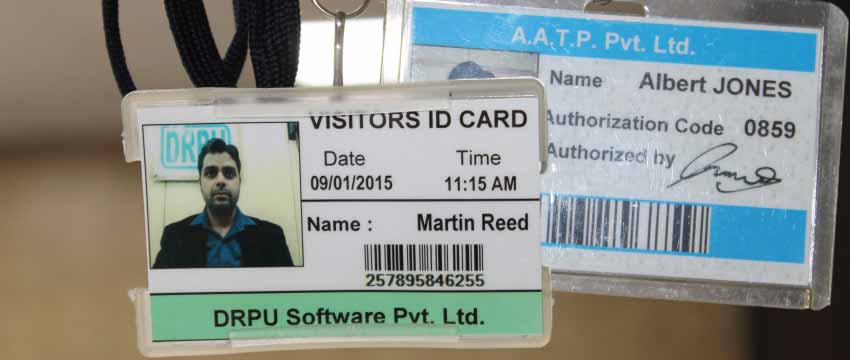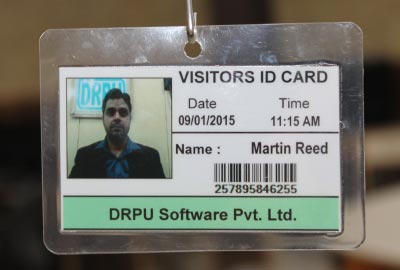-
Purpose:
Visitor ID:- A visitor ID card is issued to individuals who are visiting an organization temporarily, such as clients, contractors, or guests. It serves as a temporary identification document to grant limited access and track their presence within the premises.
Employee ID:- An employee ID card is issued to permanent or long-term employees of an organization. It serves as a form of identification and is used to grant access to various areas of the organization, track attendance, and enable other employee-related functions.
-
Duration:
Visitor ID:- A visitor ID card is typically valid for a limited period, often for the duration of the visitor's stay within the organization. Once the visit ends, the card is returned or deactivated.
Employee ID:- An employee ID card is issued for an extended period or indefinitely, as long as the employee remains with the organization. It is used throughout the employee's tenure and may be reissued or updated as needed.
-
Access and Privileges:
Visitor ID:- A visitor ID card usually grants limited access rights to specific areas within the organization. The access may be restricted to certain floors, rooms, or designated areas. Visitor cards often have clearly defined expiration dates and limited functionality to ensure security.
Employee ID:- An employee ID card provides broader access privileges based on the employee's role and responsibilities within the organization. It may grant access to multiple floors, departments, or secure areas, depending on the employee's authorization level. Employee cards often integrate with access control systems and may offer additional functionalities like time and attendance tracking or electronic payment options within the organization.
-
Design and Information:
Visitor ID:- Visitor ID cards typically have a distinct design or color scheme that differentiates them from employee cards. They usually include basic identification details such as the visitor's name, photo, visitor type (e.g., client, contractor), and the organization being visited. They may also include a visitor badge or label for easy identification.
Employee ID:- Employee ID cards often feature the organization's logo, colors, and branding, making them easily recognizable. They typically include the employee's name, photograph, job title or designation, employee identification number, and sometimes the department or team name. Employee cards may also incorporate security features like holograms, barcodes, or RFID (Radio-Frequency Identification) technology to enhance authentication and access control.
-
Security:
Visitor ID:- Visitor ID cards focus on temporary identification and tracking rather than extensive security features. They are often collected or deactivated upon the visitor's departure to ensure they cannot be reused.
Employee ID:- Employee ID cards are designed with enhanced security features to prevent unauthorized access and protect sensitive information. These features may include holograms, magnetic stripes, smart chips, or RFID technology. The security measures are more robust to safeguard against potential misuse or unauthorized duplication of the employee card.
Visitor ID Cards Customized to Match Organization's Branding
Customizing visitor ID cards with your organization's branding involves incorporating specific design elements, colors, and information that align with your brand identity. Here are the key considerations and steps involved in the customization process:
Before customizing visitor ID cards, it's essential to have a clear understanding of your organization's branding guidelines and visual identity. These guidelines typically include specifications such as logo usage, color palettes, typography, and any other design elements that represent your brand. This information will serve as a foundation for creating customized visitor ID cards.
Design elements play a vital role in aligning visitor ID cards with your organization's branding. Here are some key aspects to consider:
-
Logo Placement: The organization's logo is a central element in brand representation. Determine the appropriate placement and size of the logo on the visitor ID card. Typically, it is positioned prominently at the top or bottom of the card.
-
Colors: Select the primary and secondary colors from your organization's color palette to incorporate them into the visitor ID card design. Consistency in color usage helps reinforce brand recognition and visual association.
-
Typography: Choose the appropriate fonts and font sizes for the text on the card, such as the visitor's name, organization name, or any additional information. Consistency in typography creates a unified look with your organization's brand.
-
Imagery: If your brand includes specific imagery or graphics, consider integrating them into the visitor ID card design. This could involve incorporating background patterns, icons, or illustrations that reflect your organization's visual style.
The layout of the visitor ID card should be well-organized and easy to read. Here are some considerations for organizing the information:
-
Visitor's Name: Ensure that the visitor's name is clearly visible and easily identifiable on the card. It can be placed prominently and use a legible font size.
-
Organization Name and Logo: Display your organization's name and logo prominently on the card. It helps visitors quickly associate the card with your brand.
-
Contact Information: Include essential contact details, such as your organization's phone number or website, on the card. This information allows visitors to reach out if needed.
-
Temporary Visitor Label: Consider including a temporary visitor label or badge that clearly identifies the individual as a visitor. This can help distinguish between visitors and employees within the organization.
-
Expiration Date: If applicable, include an expiration date on the visitor ID card to indicate its validity. This is particularly important for ensuring security and preventing unauthorized reuse.
While customizing visitor ID cards to match your branding, it's crucial to maintain adequate security measures. Here are some security features to consider:

-
Holograms or Watermarks: Including holograms or watermarks on the card can help prevent counterfeiting or unauthorized duplication. These security features are often visually appealing and enhance the card's authenticity.
-
Barcodes or QR Codes: Integrating barcodes or QR codes on the card allows for easy scanning and tracking of visitor information. It facilitates efficient check-ins, access control, and visitor management processes.
-
RFID Technology: RFID (Radio-Frequency Identification) technology can be embedded in the visitor ID card for enhanced security and tracking purposes. RFID-enabled cards can be used to grant access, track movements, and improve overall security within the organization.
Choosing the right card material and printing method is crucial to ensure the quality and durability of the customized visitor ID cards. Consider the following factors:
-
Card Material: Select a durable material, such as PVC (Polyvinyl Chloride), that can withstand daily use and remain intact during a visitor's stay. PVC cards are widely used for their durability and resistance to wear and tear.
-
Printing Method: Opt for a printing method that can accurately reproduce your organization's branding elements, colors, and imagery. Digital printing or offset printing are commonly used methods for high-quality card printing.
-
Lamination: To further protect the cards and prolong their lifespan, consider laminating them. Lamination adds a protective layer that guards against scratches, fading, and water damage.
While customizing visitor ID cards, it's crucial to consider any compliance or legal requirements that may apply to your organization or industry. Some sectors, such as healthcare or government, may have specific guidelines or regulations regarding visitor identification and information display. Ensure that your customization efforts align with these requirements.
Once the design and production of the customized visitor ID cards are complete, establish a distribution process to ensure that visitors receive their cards efficiently. Determine whether the cards should be issued at a reception desk, self-service kiosk, or online registration system, depending on your organization's setup and visitor management processes.
Before finalizing the design and production of the customized visitor ID cards, conduct thorough testing to ensure that all elements are legible, visually appealing, and function as intended. Seek feedback from various stakeholders, such as employees or visitors, to gather input on the design, clarity, and effectiveness of the customized cards. Incorporate feedback and make necessary adjustments to improve the final product.
Customizing visitor ID cards to match your organization's branding involves aligning design elements, colors, typography, and imagery with your brand identity. By incorporating branding guidelines, organizing information effectively, including security features, and using appropriate card materials and printing methods, you can create professional and visually appealing visitor ID cards that represent your organization's image accurately.
| 12/07/2023

